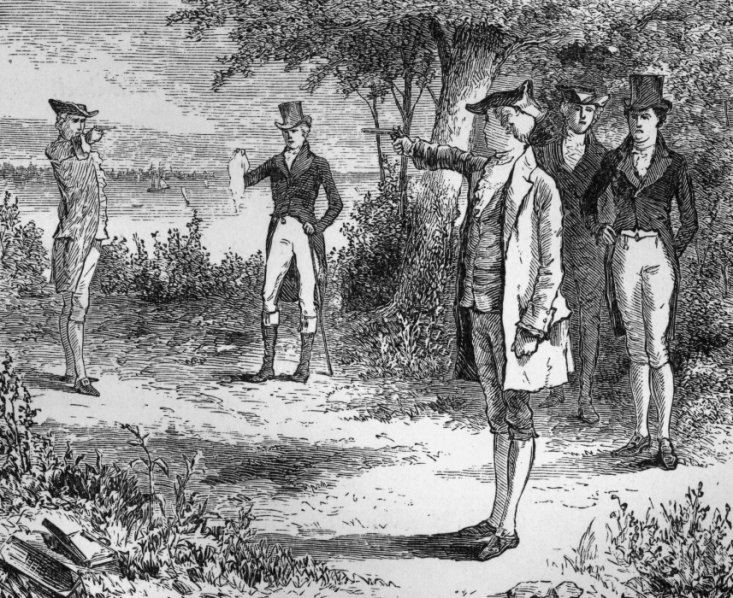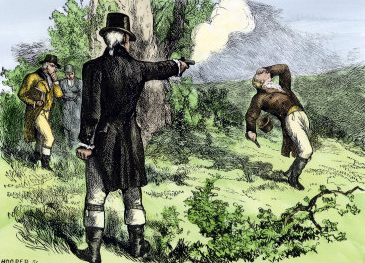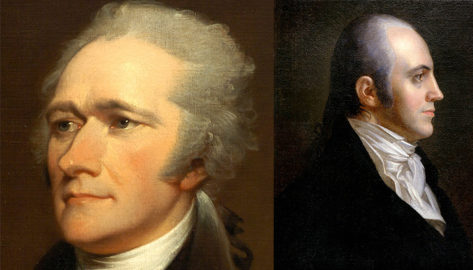By Don Radebaugh – Imagine this…the Vice President of the United States challenges one of the greatest Statesman in American history to a duel. The two characters meet, and in accordance with the protocol of the code duello, the VP pulls the trigger and kills his or her opponent in cold blood. Now I know the story seems too far-fetched…that it wouldn’t ever happen; except that it did.
In the early morning hours of July 11, 1804, Aaron Burr, the Vice President under Thomas Jefferson, shot Alexander Hamilton dead in a duel on a ledge along the Hudson River in Weehauken, New Jersey. Hamilton, gut-shot, lingered until the next day before he went to ‘Meet his Maker’ in the early afternoon hours.
Burr, although unhurt in America’s most famous encounter, was badly wounded in the eyes of the world, and never recovered from his “meeting” with Hamilton. The popular consensus of the day was that Burr murdered Hamilton in cold blood. The duel haunted Burr till the very end.
“O Burr O Burr, what has thou done?
Thou has shooted dead great Hamilton.
You hid behind a bunch of thistle,
And shooted him dead with a great hoss pistol.”
 Of course that was the poetic Hamiltonian version of what happened. Burr’s side had its own translation regarding the events as they occurred at Weehauken.
Of course that was the poetic Hamiltonian version of what happened. Burr’s side had its own translation regarding the events as they occurred at Weehauken.
Duels of the day were not necessarily out of the ordinary; in fact, Hamilton’s 19-year-old son Philip died in a duel nearly three years earlier. What set this duel apart were the real-life actors involved. Burr was the second highest ranking politician in the federal government. Hamilton, the secretary of the Treasury under George Washington, was the most powerful figure in the Federalist party, not to mention a Founding Father. It was an unfolding drama that stretched out over 15 years during which Hamilton and Burr took political and personal shots at one another.
The “why and how” this all happened has been the source of discussion for hundreds of years, although the “why” part was way easier to figure out than the “how.”
In regards to why, Burr — who delivered his share of barbs over the years — had decided he had had enough, and without an official, unqualified apology he demanded after their 15-year competition, challenged Hamilton to a duel. Hamilton of course could have refused, but his honor and reputation would have been at stake. With political aspirations still burning deep in his soul, Hamilton knew he had to answer his enemy. Hamilton also knew that most duels in this era did not result in death or even serious injury. An exception to the rule was fast approaching.
If the story isn’t already strange enough, it got even more so when on July 4, less than a week from “the interview” at Weehauken, Burr and Hamilton sat at the same dinner table and broke bread together at the annual Independence Day celebration. Artist John Trumbull recorded the scene.
“The singularity of their manner was observed by all, but few had any suspicion of the cause. Burr contrary to his wont, was silent, gloomy, sour; while Hamilton entered with glee in the gaiety of a convivial party, and even sung an old military song.”
On the fateful morning of The Duel, each man was accompanied by personal assistants. Hamilton brought his own loyal associate Nathaniel Pendleton as well as his physician, Dr. David Hosack, while Burr came with his own devoted disciple William Van Ness. Just before the fatal shot was fired, Pendleton and Van Ness met briefly to review the agreed upon rules. Because Hamilton was challenged, he had the choice of weaponry. Hamilton chose a pair of family-owned custom-made pistols. They were the same pistols used in the duel in which killed his son in 1801. Then Burr and Hamilton met in the middle to receive their final instructions.

After 10 paces, the men found themselves on the extreme edge of the ledge. After Pendleton uttered the word, “present” both were free to fire. If one fired before the other, the other man, after a “1-2-3-fire” count, could shoot back. If both men missed, accidentally or purposely, a conference was held to determine if another round was needed or if the obligations of honor were met.
The post-duel conference, however, would not be necessary after Burr’s .54 caliber ball tore through Hamilton’s lower abdomen on the right side, bounced off his rib cage and lodged in his spine. When Dr. Hosack rushed forward to assist, Hamilton said, “This is a mortal wound doctor,” and then lapsed into unconsciousness.
Meanwhile Burr seemed shocked by what just happened as Van Ness ushered him from the ledge. Burr insisted on going back, pleading, “I must go and speak to him.” Van Ness refused Burr’s request and moved him along to his barge that carried both back across the river to New York.
Immediately both sides crafted their own tailor-made accounts of what exactly happened. The problem was that different versions began to circulate. Some even said that Hamilton never fired. However, both Pendleton and Van Ness agreed that two shots were indeed fired…the interval between would be argued forever. At any rate, both versions that surfaced likely misrepresent what actually happened. In the meantime, Burr fled and didn’t stop until he reached Georgia.
What really took place on the plains of Weehauken has been one of the greatest mysteries in American history. Based on all the available evidence, Joseph J. Ellis’s version as the author of “Founding Brothers” is the most compatible with all of the evidence that exists.
Hamilton did fire his weapon first but he purposely led his bullet into a tree above and behind Burr, “wasting” his shot. Meanwhile, Burr, who did not know that Hamilton came with intentions to miss, was well aware of the projectile that just whizzed over and close enough to his head. According to the guidelines of the code duello, Burr had every right to take aim at Hamilton and fire with intent to kill, which he most certainly did.
We can never know for certain what exactly happened other than the result that followed. Most assuredly, Burr knew that killing Hamilton was the equivalent of political suicide…that he had nothing to gain and everything to lose. Or, it’s possible that by that time, Burr was beyond his senses with anger…that any rational thoughts that held his long-term interests in mind were long gone. Ready, fire, aim.
What is certain based on all the evidence is that Hamilton fired first and purposely missed his target. It’s certainly possible that Burr missed his target too, but accidentally hit. Pistols in those days, packed with round mini-balls, were notoriously inaccurate. Nonetheless, Hamilton was still dead either way.
With Burr on the run into the deep south, Hamilton died at 2 p.m. on July 12 surrounded by Episcopal bishop of New York Benjamin Moore, Dr. Hosack, Hamilton’s wife Elizabeth and their seven surviving children.
Even if Hamilton was past his political prime – the Federalist party he founded was indeed dying – he got the country off on solid financial footing during its most precarious moments, when it needed it the most. As the main author of the Federalist Papers, the precursor to the U.S. Constitution, and the founder of our nation’s financial system that’s still in play today, he did more for America, arguably, than the overwhelming majority of most. And it was Hamilton who out-maneuvered both Jefferson and Madison to get his financial system through congress in exchange for the removal of America’s capital city from Philadelphia to Washington D.C. Jefferson and Madison, both Virginians, thought they were getting the better bargain, only to realize not too soon afterward, that Hamilton got the better of both. In the end, it was America that benefited the most from Hamilton’s amazing mind.
Thanks Alexander, and congrats on your smash-hit Broadway musical…you’re still a star.
Find the History Mystery Man on Facebook and YouTube.

